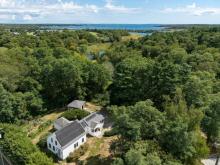Bog Wind developer presents scaled-back plan to Zoning Board, public
Continuing months of often emotional debate, developer Glen Berkowitz of Boston-based Beaufort Windpower LLC formally presented a scaled-back plan for the controversial Bog Wind project to the Zoning Board of Appeals Wednesday night.
The current plan is the third presented by Berkowitz after he presented a first revised plan in September due to what he called legitimate concerns from residents opposed to the project.
Berkowitz asked that petitions 13-10 and 14-10 be withdrawn, killing the turbines on Blackmore Pond Road and tower #5 at Charge Pond Road. The withdrawal means neither Beaufort Windpower nor another developer can file for permission to construct wind turbines on the sites in question for a minimum of two years.
Beaufort Windpower is now seeking Zoning Board of Appeals approval only for the construction of two towers on Charge Pond Road. In the new proposal, the location of the towers were moved further away from the road.
The new turbines would be reduced in size roughly 20%, with a height of 263 feet, reduced from the previously proposed 328 feet, and with a rotor diameter of 271 feet instead of 332 feet. In addition, the "swept area," the circle formed by the blades of the turbine, has been reduced to 57,680 square feet as opposed to 86,570 square feet. The new proposal also reduces the maximum power generated by the project from 2.5 megawatts to 1.6 megawatts.
“Simply stated, we had a change of heart," Berkowitz said. "After what we learned in the previous hearings we rethought things.”
Berkowitz went on the explain that the new turbines would conform to the Cape Cod Commission’s new pending minimum performance standards, considered to be the most stringent in the country.
The new standards require that the turbines sit a minimum of ten times the rotor diameter, 2,707 feet in the case of Bog Wind, from the nearest residences.
“By willingly adhering to those standards and having the project this well-sited there’s no reason not to push forward,” said Liz Argo, representing the Cape and Islands Wind Information Network, referring to the fact that Beaufort Windpower is imposing the standards on themselves willingly as Wareham is not affected by the Cape Cod Commission’s regulations.
The reduced power output of under two megawatts also qualifies the revised project for net metering where 100 percent of power output could be sold to Wareham for less than the current price of electricity, Berkowitz said.
Beaufort Windpower believes the project would result in $4.33 million paid or saved to Wareham over the 20-year life of the project.
Echoing comments at previous hearings, residents cited noise concerns, possible flaws in Beaufort Windpower’s noise study, and the sudden changes to the proposal as reasons for the Zoning Board to proceed with caution.
Neil Anderson, a resident of Falmouth who lives near the Falmouth 1 turbine expressed concern regarding the "infrasound" of the proposed turbines. Infrasound is an inaudible, low frequency noise that may be related to various health concerns associated with wind turbines such as increased heart rate. Anderson said he and his wife also experienced infrasound from Falmouth’s other wind turbine, which sits nearly 3,000 feet from their home.
Infrasound, Anderson said, is not formally taken into account in any studies or models of potential wind turbine sites, however, Argo rebutted Anderson saying that infrasound is directly correlated to regular sound and the new, quieter turbines would have reduced infrasound as a result.
Residents’ responses were cut short due to the changes in the plan, with several residents who planned to speak electing to wait until the continuation of the hearing in June.
The Zoning Board of Appeals unanimously voted to continue the hearing at 6:30 p.m. on June 8.











